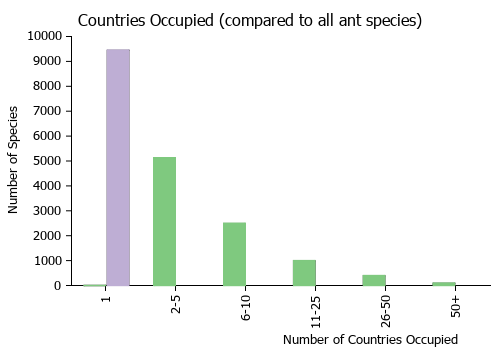Pheidole sculpturata dignata
| Pheidole sculpturata dignata | |
|---|---|
| Scientific classification | |
| Kingdom: | Animalia |
| Phylum: | Arthropoda |
| Class: | Insecta |
| Order: | Hymenoptera |
| Family: | Formicidae |
| Subfamily: | Myrmicinae |
| Tribe: | Attini |
| Genus: | Pheidole |
| Species: | P. sculpturata |
| Subspecies: | P. sculpturata dignata |
| Trinomial name | |
| Pheidole sculpturata dignata Santschi, 1915 | |
Taylor et al. (2018) suggest that this taxon is a junior synonym of Pheidole sculpturata welgelegenensis, but without comment or justification. This treatment has not been followed by subsequent authors.
Identification
A member of the excellens species group.
Distribution
Distribution based on Regional Taxon Lists
Afrotropical Region: Congo (type locality).
Distribution based on AntMaps
Distribution based on AntWeb specimens
Check data from AntWeb
Countries Occupied
| Number of countries occupied by this species based on AntWiki Regional Taxon Lists. In general, fewer countries occupied indicates a narrower range, while more countries indicates a more widespread species. |

|
Estimated Abundance
| Relative abundance based on number of AntMaps records per species (this species within the purple bar). Fewer records (to the left) indicates a less abundant/encountered species while more records (to the right) indicates more abundant/encountered species. |

|
Biology
Castes
Nomenclature
The following information is derived from Barry Bolton's Online Catalogue of the Ants of the World.
- dignata. Pheidole sculpturata st. dignata Santschi, 1915c: 250 (s.w.) CONGO.
Description
References
- Santschi, F. 1915c. Nouvelles fourmis d'Afrique. Ann. Soc. Entomol. Fr. 84: 244-282 (page 250, soldier, worker described)
- Taylor, B., Agoinon, N., Sinzogan, A., Adandonon, A., Kouaguou, Y. N., Bello, S., Wargui, R., Anato, F., Ouagoussounon, I., Houngbo, H., Tchibozo, S., Todjihounde, R., Vayssieres, J.F. 2018. Records of ants (Hymenoptera: Formicidae) from the Republic of Benin, with particular reference to the mango farm ecosystem. Journal of Insect Biodiversity 8(1): 6-29 (doi:10.12976/jib/2018.08.1.2).